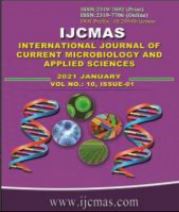


 National Academy of Agricultural Sciences (NAAS)
National Academy of Agricultural Sciences (NAAS)

|
PRINT ISSN : 2319-7692
Online ISSN : 2319-7706 Issues : 12 per year Publisher : Excellent Publishers Email : editorijcmas@gmail.com / submit@ijcmas.com Editor-in-chief: Dr.M.Prakash Index Copernicus ICV 2018: 95.39 NAAS RATING 2020: 5.38 |
Productivity growth in horticulture is essential for the development of the sector. This paper has reviewed the developments in mango productivity related to the Konkan Region Mahrashtra. The TFP growth and its contribution in production growth have been summarised for Konkan region of Maharashtra over the past two decades. The total factor productivity indices of mango estimated using Tornqvist index for study period 1998-99 to 2017-18. TFP index was promising for the study period; it indicated that the inputs were efficiently allocated in mango plantation. TFP increased at 2.93 per cent per annum. During the same period, output index grew by 2.05 per cent per annum and input index declined at the rate of 0.86 per cent per annum. The improvement in the total factor productivity was may be due to non-input factor such research investment and extension efforts. The results indicate that research investment (00.18), rainfall (0.55), road density (0.63) and rural literacy (2.05) have significantly contributed to TFP growth in mango. Estimated value of marginal returns was 53.25 it indicates that an additional investment of one rupee in mango research generated additional income of ₹ 53.25. The inverse of TFP elasticity to research gives flexibility to research investment. The estimated value was 5.56 which mean that to achieve one per cent growth in TFP, the investments in research need to be increased by 5.56 per cent for mango in Konkan region of Maharashtra. This paper would provide useful information to the people interested in doing research on these issues. Some of the concerns raised in this paper on total factor productivity would provide direction for future research in this area.
 |
 |
 |
 |
 |